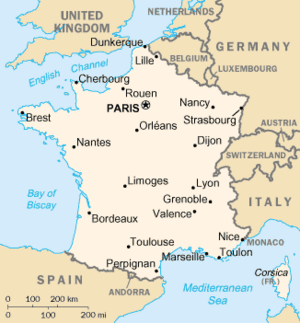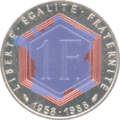Metropolitan France facts for kids
Metropolitan France (French: France métropolitaine or la Métropole) is the part of France that is in Europe. It can also be described as mainland France plus the island of Corsica. By contrast, Overseas France (France d'outre-mer) is the collective name for all of the French overseas departments, territories and collectivities and New Caledonia. Metropolitan France and Overseas France together form the French Republic.
Metropolitan France covers an area of 551,695 km² (213,011 sq. miles). Excluding the territory of Adélie Land in Antarctica, this is 81.8% of the nation's territory. As of January 1, 2011, 63,136,180 people lived in metropolitan France. This is 95.9% of the nation's population.
The five overseas departments – Martinique, Guadeloupe, Réunion, French Guiana, and Mayotte – have the same political status as the departments in metropolitan France. Metropolitan France and these five overseas departments together are sometimes called France entière ("entire France") by the French administration, especially by INSEE. This grouping does not include the French overseas collectivities and territories, which have more autonomy than the overseas departments.
Related pages
Images for kids
-
l'Hexagone illustrated by overlaying the outline of mainland France with the hexagon on the 1988 Charles de Gaulle commemorative 1 franc coin. Going counterclockwise, the sides of the hexagon are: 1. the Channel coast, 2. the Atlantic coast, 3. the Pyrenees (border with Spain), 4. the Mediterranean coast, 5. the eastern border (Alps, Jura and Upper Rhine; Monaco to Karlsruhe), and 6. the northeastern border (German Rhineland, Belgium and Luxembourg; Karlsruhe to Dunkirk).
See also
 In Spanish: Francia metropolitana para niños
In Spanish: Francia metropolitana para niños




